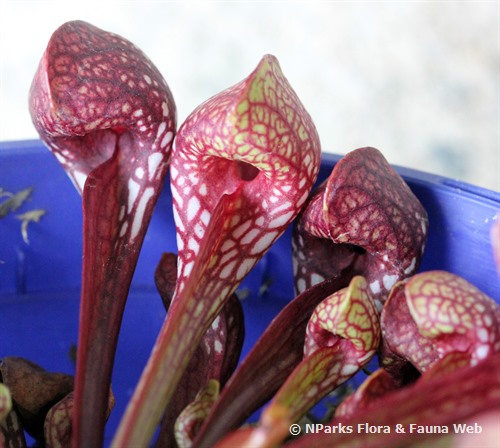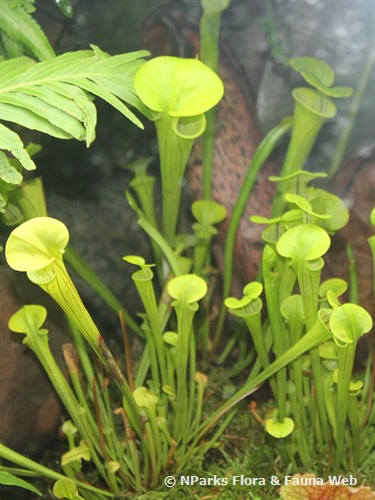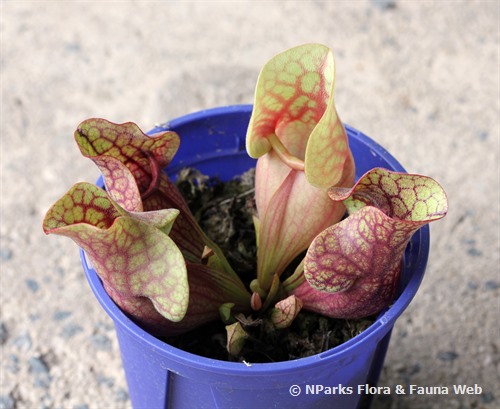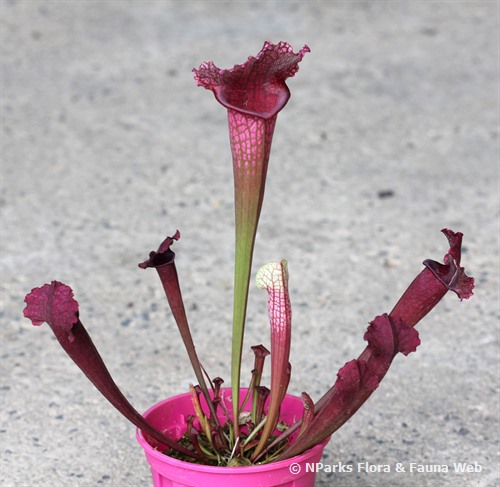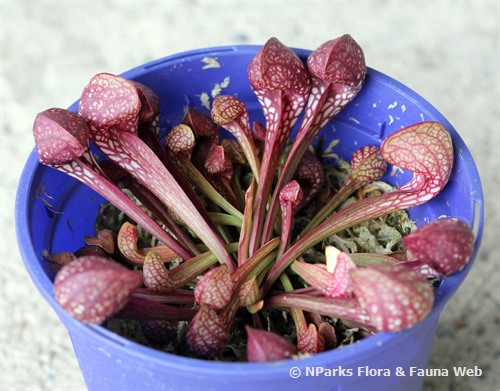
Back
Sarracenia psittacina
| Family Name: | Sarraceniaceae |
| Common Name: | Parrot Pitcher Plant, Lobster Pot |
Name
Classifications and Characteristics
| Plant Division | Angiosperms (Flowering Seed Plants) (Dicotyledon) |
|---|---|
| Plant Growth Form | Herbaceous Plant |
| Lifespan (in Singapore) | Perennial |
| Mode of Nutrition | Autotrophic |
| Maximum Plant Spread / Crown Width | 50 cm |
Biogeography
| Native Distribution | United States |
|---|---|
| Native Habitat | Terrestrial (Freshwater Swamp Forest) |
| Preferred Climate Zone | Temperate |
| Local Conservation Status | Non-native (Horticultural / Cultivated Only) |
Description and Ethnobotany
| Growth Form | Small herbaceous plant forming a rosette up to 15 cm tall. |
|---|---|
| Foliage | The hooded, tubular leaves are modified into snake-like pitchers (up to 25 cm long). They are initially erect and later lie prostrate with the small opening facing the centre of the plant. Each leaf has a central wing down the base of the leaf which provides structural support. Under very dry soil conditions, the leaves become flat and lose their ability to trap insects. The pitchers attract insects with their bright colors and nectar produced by extrafloral nectaries located near the opening. An insect that enters the tube has difficulty getting out, because hairs on the inside prevent escape. |
| Stems | The leaves are produced from an underground, horizontal stem known as a rhizome. |
| Flowers | Small, red flowers hang down singly from a 25 cm scape and are partly covered by yellow bracts. |
| Habitat | Found mostly in temperate bogs, swamps, wetlands and pine forest margins of southeastern United States (Georgia, Florida, Alabama, Louisiana). When it is occasionally flooded for a short period, it traps small swimming prey. |
| Cultivation | It grows best in very wet media, such as half peat moss and half perlite. Under full sun, the white patches occurring among the red venation (known as fenestration) becomes more distinct. Unlike other carnivorous plants, it grows better when fertilized. |
| Etymology | The genus Sarracenia is named after Michel Sarrazin, a botanist and surgeon from Quebec, Canada. |
Landscaping Features
| Desirable Plant Features | Ornamental Foliage |
|---|---|
| Landscape Uses | Interiorscape/ Indoor Plant, Container Planting, Terrarium |
| Thematic Landscaping | Marsh Garden |
Plant Care and Propagation
| Light Preference | Full Sun |
|---|---|
| Water Preference | Moderate Water |
| Rootzone Tolerance | Moist Soils, Poor Infertile Soils, Acidic (low pH) Soils |
Foliar
| Foliage Retention | Evergreen |
|---|---|
| Mature Foliage Colour(s) | Green, Red, Patterned |
| Mature Foliage Texture(s) | Smooth |
| Prominent Young Flush Colour(s) | Green, Red, Patterned |
| Young Flush Texture(s) | Smooth |
| Foliar Modification | Pitcher Trap |
| Foliar Type | Simple / Unifoliate |
| Foliar Arrangement Along Stem | Rosulate / Rosette |
| Foliar Shape(s) | Non-Palm Foliage |
| Foliar Venation | Recticulate |
| Foliar Margin | Entire |
| Mature Foliage Colour(s) Remarks | Burgundy |
Floral (Angiosperm)
| Flower Colour(s) | Red |
|---|
Image Repository
Others
| Master ID | 32920 |
|---|---|
| Species ID | 7334 |
| Flora Disclaimer | The information in this website has been compiled from reliable sources, such as reference works on medicinal plants. It is not a substitute for medical advice or treatment and NParks does not purport to provide any medical advice. Readers should always consult his/her physician before using or consuming a plant for medicinal purposes. |

